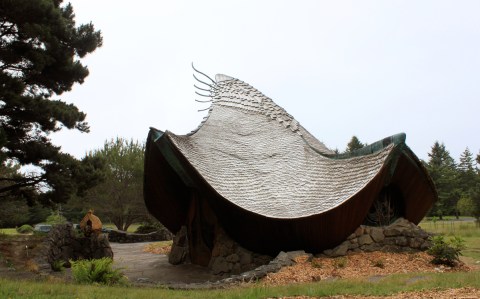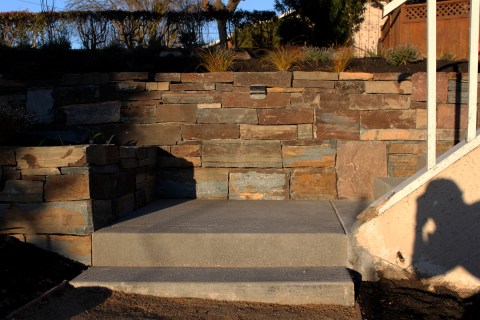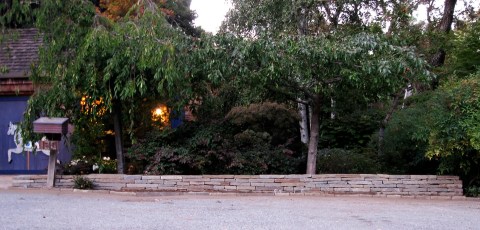Archive for the ‘stone’ Category
Barker Dam
My last post on Joshua Tree is from Barker Dam, aka Big Horn Dam. The park is a desert, but it received more rainfall a hundred years ago and homesteaders tried raising cattle there. A couple of ranchers in the area made a seasonal reservoir, first a rancher named Barker in the early 1900’s, then William Keys fifty years later. Personally, I thought it was a little weird to see this empty reservoir and rather jury-rigged dam in the middle of the desert. Keys was the kind of guy who would kill someone in a dispute and then make a stone marker to commemorate/brag about it afterwards, and some of that character (or lack thereof) shows in the design and craftsmanship of the dam. But the birds seem to like it and the visuals are interesting and it’s a stone structure on the national register of historic places, so here it is.
The reservoir was done in a couple of phases; the bottom nine feet are faced with rock and the upper six feet of concrete were added by Keys in 1950. He made a sign in a smear of concrete to commemorate/brag about this too.
The concrete had rock dumped in between the forms to save money. You can actually make a pretty nice wall this way if you place the rock a little more carefully and scrub more concrete off the faces off after you take away the forms.
Behind the dam there’s an interesting pattern of bathtub rings. Apparently the reservoir still fills to the top, flooding twenty acres during the wettest time of year.
There’s a second, lower dam below the main one, full of cattails living off the seepage.
And a cattle trough below the second dam. All in all, a funky little area.
Sea Ranch Chapel
While I was at Salt Point, I visited the Sea Ranch Chapel just north of there. The chapel’s a fantastic building designed by San Diego architect James T. Hubbell, commisioned by two sea Ranch residents who wanted to create a ‘nondenominational sanctuary for prayer, meditation, and spiritual renewal.’ I love the form and the blending of materials.
The design was inspired by the drawings of a local artist and is said to be based on winged forms. It also has a bit of shell motif going, though it’s of course abstract enough to offer a variety of interpretations. Personally, I think it resembles a brugmansia flower.
The Hubbell website says the supervisor on the project had experience as a boat builder, which makes a lot of sense; the framing looks like it’s for a boat, and the finished building looks somewhat like a sea vessel sitting on a cradle of rock. The moss rock (aka Sonoma fieldstone) is actually a facade over a cinder block wall, but the batter makes it look structural.
The section and the construction photo are from the chapel’s website, which also has a nice aerial photo of the building.
The interior is as striking as the exterior, with a flagstone floor, stained glass windows, and lots of beautiful woodwork. The windows and the wood made the building feel warm, even though the sky still was gray with its coastal-morning haze.
It’s all very compelling and a steady flow of people visited while I was there, drawn off the highway to investigate. You don’t really see many buildings that combine rock and wood and glass and metal in such a unique way. Really well done.
Salt Point State Park
I took a couple of days this week to go climbing and hiking at Salt Point State Park up the coast between Jenner and Sea Ranch. I’d never been before, it’s a little far for a day trip, but now the impending closure of so many state parks has got me motivated to check out some of the parks I’ve always meant to visit. Salt Point isn’t one of the ones that will be closing, but that’s partly because they have already cut back many of the services. The closures didn’t really affect my visit, I had a great time, but it was a reminder of how things are trending. But in any case, I wasn’t dwelling on that during my trip, mostly I was just enjoying the park. Classic Northern California coastline, lots of wildflowers in bloom, and I was lucky to enjoy perfect weather. I’m not sure photos can show how exceptionally pleasant it was.
Salt Point was a quarry in the 1850’s. Sandstone slabs were split and shipped down to San Francisco to use as paving and wall stone; you can still see drilling scars on some of the rocks.
It’s great to see a former quarry site looking so beautiful.
Altun Ha Mayan Ruins
Hmmm, I meant to post this sooner. Our Belize vacation already feels like it was a long time ago. As I mentioned just after we got back, we spent most of our Belize vacation on a small island, hanging out, sometimes snorkeling but mostly just sitting in a hammock. At the end of our trip we did one true sightseeing thing, we went to the Mayan ruins of Altun Ha.
Anita and I have both been to Mayan ruins before, but not for about ten years. Altun Ha is a good one. The entire site is about 25 square miles, mostly focused around two main plazas that are cleared and excavated, with pyramids as tall as the trees. The name means Stone Water or Rockstone Pond, named for the limestone wells. It was settled around 250 BC, with the first buildings going up around 100 AD. The population got up to 10,000 people at it height; it was abandoned around the 10th century. Now there’s just forest around it and it would be hard to imagine a lot of people ever living there if it weren’t for the big stone pyramids.
Mayan ruins are great, and I of course was interested in the stonework. Each building was built over about a one hundred year period, sometimes directly on top of previous buildings. During the Mayan times the stone would have also been covered with stucco and painted.
More detail photos than anyone really needs to see are below. (more…)
Wall Lighting
A little before we left for Belize I finished a project in Walnut Creek that I’d been working on for a while. No garden is ever truly finished and there are still a few things to do in this one — redoing the handrailing, painting the wall — but I’m not the one responsible for that phase so I get to call it done. Much of this project was done during the period of heavy winter rains in December and then there was a long delay while the light fixture for the wall was decided on and then fabricated. Landscape lighting generally gives more immediate gratification than any other aspect of landscaping, but we had a hard time finding the right fixture for this one. There are tons of lantern-style lights designed for eight-foot-high stuccoed walls, but not many for a three foot retaining wall of stone.
Some photos of lighting (which for some reason has attracted the biggest flurry of spam that I’ve seen in a long time) are below. (more…)
Elk Mtn. Tumbled Edging with Flowers
Thursday while I was down on the peninsula, I passed near a house where I did a small stone project last fall, so I stopped by to check out the planting that the client did afterwards. Pretty nice, and fun to see someone else’s plant choices. There wasn’t a drawing or anything when I did the project, just a request for an 8″ high wall to give a back drop to a low planting of color, and I didn’t know exactly what would go in afterwards. You can’t see so much of the stonework at the moment, but it will reappear as the plants finish their bloom cycles.
The yard had nice trees and shrubs before, but it’s a lot more interesting now. This photo from when I finished the project was in my 2010 wrap-up post.
You are currently browsing the archives for the stone category.



































